14.09.2007
M.Notkin. Black Misfortune
Let us start with aces. By opening our review by the game between two world champions we shall behave as gentlemen: beautiful ladies of arbiters' council gave the highest rank to the duel. Thorough computer analysis reveals some roughness but you can expect nothing else of a rapid game with an extremely high tension. A strategic scale excuses tactical flaws fully. R.Kasimdzhanov – V.Topalov 1.d4 ¤f6 2.c4 g6 3.¤c3 Ґg7 4.e4 d6 5.f3 0–0 6.Ґe3 c5 7.¤ge2 ¤c6 8.d5 ¤e5 9.¤g3 e6 10.Ґe2 exd5 11.cxd5 h5 12.0–0 ¤h7 13.Јd2 h4 14.¤h1 f5. A standard program of Benoni is carrying out for the present. A plan with 14...g5 also has been employed in this position repeatedly. 15.¤f2 Ґd7 16.¦ab1. A struggle of ideas is typical for the scheme, so speaking of any novelty 'to the point' makes no big sense. I shall show a couple of examples from grandmasters' games. In the rapid game Bischoff – Radjabov, Mainz 2005, after 16.a4 a6 17.a5 Јf6 White carelessly played 18.Јc2? and met with 18...f4 19.Ґd2 h3 20.¤xh3 Ґxh3 21.gxh3 Јh4 – Black has very pleasant position from both chess and psychological points of view. Moiseenko – Ponomariov, Alushta 2000: 16.f4 ¤f7 17.e5 dxe5 18.Ґxc5 ¦e8 19.fxe5 Ґxe5 20.¤d3 Јc7 21.h3 ¤hg5 22.Ґf3 b6 23.Ґe3 Ґf6, and Black has no complaints. 16...Јf6. Threatening with f5-f4 and preventing b2-b4. 17.f4 ¤f7 18.ўh1. This move passing to the opponent might turn out very successful if Rustam would make full use of the next mistake by Veselin. 18...¦fe8? As the idea e4-e5 with trading the e-pawn for the c-pawn is soaring around, Topalov hardly planned 18...a6 weakening dark squares on the queenside. But he should play 18...b6 then, for instance. The text move puts the rooks under a double attack. 19.¤b5! Јd8. There is no suitable defence: 19...¦e7 loses an exchange due to 20.e5 dxe5 21.Ґxc5; 19...Ґxb5 20.Ґxb5 ¦ed8 21.b4 is bad positionally. 20.b4 b6. In the case of 20...a6 Kasimdzhanov would possibly answer 21.¤c3 cxb4 22.¦xb4 b5 23.Ґd4 with a mere pleasant position. The opponents do not seem to take into account an idea mentioned in the next note, which would lead to a position pleasant for White in every aspect. 21.bxc5 bxc5 22.Ґd3? A sacrifice 22.¤xd6! ¤xd6 23.e5 would be much stronger. The idea is to seize the pawn on c5 rather than to regain the material. Black would have to return the piece himself at last when White's central pawns will bind all the opponent's minor pieces. Computer votes for the sacrifice even on move 20 though here the position estimate is not so clear. 22...¤f6 23.¤c3. An inglorious retreat. More of principle is 23.e5!? with a complicated play after 23...dxe5 24.d6. Bad for Black is 23...¤xd5 24.Ґc4 ¤xe3 25.Ґxf7+ ўxf7 26.¤xd6+ ўg8 27.Јxe3, or 24...Ґxb5 25.Ґxd5 Ґxf1 26.e6! 23...Јa5. Simple 23...fxe4! would gain a pawn as 24.¤fxe4 ¤xe4 25.¤xe4 c4 26.Ґc2 Ґf5 led to more serious losses for White since his queen is overloaded by care of the bishops. White probably has some compensation either after 24.¤cxe4 ¤xd5 25.Ґc4 ¤xe3 26.Јxe3 Ґe6 27.Ґxe6 ¦xe6 or in the case of refusing of the capture on e4, but a pawn is a pawn, and 23...fxe4 deserved serious attention. 24.Јc2. After 24.exf5 White should consider 24...¦xe3 25.fxg6 ¤h6 26.Јxe3 Јxc3 as well as the capture in reply. 24...¤g4! Topalov grabs the initiative using the opponent's minor pieces' hanging position. 25.¤cd1. 25.¤xg4 would be followed by 25...Јxc3; on 25.Ґd2 – 25...¤xf2+ 26.¦xf2 c4!, and if 27.Ґxc4?! then 27...Јc5 28.¤d1 ¦ac8 29.¦c1 ¦xe4. Still White should opt for one of these continuations as he is not obliged to take on c4 in the latter variation. 25...Ґa4? Obviously, Veselin did not want to remove tension in the centre out of general considerations, however, tactical nuances are more important here. After 25...fxe4! all variations are to Black's benefit, for example 26.¤xe4 (26.Ґxe4 Јa4!) 26...c4! 27.Ґxc4 Ґf5 28.Ґd3 ¦ac8 29.Јe2 h3! weakening the big light-squared diagonal at first an only then beginning to eliminate white pieces on it, or 27.Јxc4¦ac8 – here White has several tricks to minimize his losses but the position estimate is the same. 26.Јe2 Ґxd1 27.¤xd1. 27.¦bxd1 is of approximately equal value but Rustam did not wish to withdraw his rook from the open b-file. 27...¤fh6? 27...fxe4 28.Ґb5! ¦eb8 29.a4, or 29.Јxg4 ¦xb5 30.¦c1, and Black will face troubles on the kingside. 27...c4 deserved attention, and in the case of 28.Ґxc4?! ¦xe4 29.Ґd3 ¦xe3 30.¤xe3 ¦e8 31.¤c4 ¦xe2 32.¤xa5 ¦xa2 33.¤c6 ¤f2+ 34.¦xf2 ¦xf2 White would have to struggle for a draw in the endgame. Maybe in this game Topalov wanted to prove something to Dr Tarrasch: one knight hardly got out of h7 as world ex-champion sent another to the edge of the board thus handing in the initiative to the opponent. 28.Ґd2! 28.¦b7 was also possible, or 28.e5 dxe5 29.Ґd2 Јd8 (29...Јxa2 30.¤c3 Јa5 31.Ґb5) 30.Ґb5. 28...Јxa2 29.¦b7. Immediate 29.e5 would force Veselin to move 29...c4! at last, and to save material White would have to escape to the endgame by 30.Ґc3! Јxe2 31.Ґxe2 dxe5. 29...Јa3. White threatened with striking on g7 winning the queen. 30.e5! dxe5. Man's vision is such organized that after moving the queen on a3 it is difficult to switch attention to the opposite side of the board at once. Perhaps we would play chess stronger if our eyes could look in different directions... All-seeing computer offers brilliant 30...¤xh2! 31.ўxh2 c4! with a complicated play after 32.Ґc3! while naive 32.Ґxc4? leads to a loss after 32...¤g4+ 33.ўg1 Јg3! 34.Јxg4 Јxg4 (but not 34...fxg4? 35.¦b3) 35.¤e3 Јh5. 31.d6. The moves 31.Ґc3 and 31.Ґc4 have their merits. The text move is hardly weaker though suspense lovers may blame it. 31...ўh8 32.d7. 32...¦e7! Of course, not 32...¦ed8? 33.fxe5, and the pawn on e5 is untouchable. 33.fxe5. Bad is 33.d8Ј+? ¦xd8 34.¦xe7 Јxd3 35.¦e8+ ўh7 36.Јxd3 ¦xd3 37.Ґc3 ¦xd1. 33...¦xe5 34.Јf3 ¦d8 35.Ґb5 Јa2. Black defends by only moves. 35...Јxf3? 36.gxf3 and then Ґa5. 36.Ґg5. It is hard to say if immediate 36.Ґf4 would be stronger. The text move does not bring direct benefits but makes Black to weaken his knight on h6. 36...Ґf6 37.Ґf4. On 37.Ґxf6+ ¤xf6 38.Јf4 Black has 38...¤hg4! (but not 38...¤f7 39.Ґc4) 39.h3 ¤h5 40.Јg5 ¤gf6 41.Јxg6 (41.Јh6+ ¤h7 threatening with check on g3) 41...Јg8! with the upper hand. 37...a6. Also deserved attention 37...g5!? 38.Ґxe5 ¤xe5. 38.Ґc6? An error making White's position critical. 38.¦a7! kept intrigue. 38...g5! The exchange sacrifice activates the cumbersome construction on the kingside with great effect. 39.Ґxe5. Rejecting the sacrifice does not help: 39.Ґc1 Јe6 40.h3 (40.Ґd2 Јd6 attacking d2 and h2) 40...¦e1! 41.hxg4 ¦xf1+ 42.Јxf1 Јxc6 with a large material advantage for Black. 39...¤xe5 40.Ґd5. On 40.Јc3 Black coolly answers 40...ўg7. 40.Јd5 was possible aiming at the queens exchange: 40...Јe2 41.¦g1 ¤d3 42.Јf3 or 40...Јxd5 41.Ґxd5 ¤xd7 42.¦a7. 40...Јd2 41.Јb3 ўg7! A prophylactic measure against Јb6. Computer likes 41...¤xd7 at first glance, but why one would withdraw the knight from the centre and to uncover the seventh rank for the sake of elimination of the safely blocked pawn? 42.Ґe6. More stubborn is 42.h3 depriving the knights of the g4 square. 42...Јe2 43.¦g1 f4? The opponents exchange mistakes on the next moves. 43...¤eg4! is much stronger leaving the e5 square for the queen, for example 44.h3? Јe5! 45.hxg4 ¤xg4 46.g3 (46.Јh3 Јxe6) 46...Јe4+ 47.¦g2 h3 mating. 44.h3? After 44.Јb2 Black still would have to work hard. Now Veselin must play 44...f3! at once but he gives Rustam another chance to put his queen on b2 which the latter misses. 44...c4 45.Јb6 f3. Now there will be no mercy. 46.Јf2 46...¤d3! Gaining the decisive material advantage. 47.Јxf3 Јxe6 48.¦f1 ¤f4 49.¤e3 c3 50.¦d1 ¤f5 51.¦e1. Objectively, 51.¤xf5+ Јxf5 changes nothing but it was still worth to diminish the number of the opponent's attacking pieces. 51...¤g3+ 52.ўh2 [52.ўg1 Ґd4] 52...Ґe5 53.¤g4 ¤fe2 54.Јd3 Ґf4. A nice finale was possible: 54...¤e4+ 55.ўh1 Јxg4! 56.hxg4 ¤f2#. Topalov apparently misses White's answer when withdrawing his bishop from attack. Luckily, Black's position is extremely strong and cannot be spoiled by a small mistake. 55.Јxc3+ ўf7 56.Јd3 ¤f5+ 57.g3. In the case of 57.ўh1 ¤eg3+ 58.ўh2 Јxe1 White has only a couple of checks: 59.Јb3+ ўg7 60.Јb2+ ўh7. 57...hxg3+ 58.ўg2 ¤h4+. 59.ўf1. Mate by a pawn 59.ўh1 g2# would be more spectacular. 59...g2+ 60.ўf2 Ґg3+ 61.Јxg3 ¤xg3. Computer offers to win the enemy queen without giving away the own one: 61...Јf5+ 62.ўxe2 Јc2+ 63.ўe3 ¤f5+. Let us forgive it. White resigned. The following game is the only one won by White. S.Kudrin – К.Mekhitarian 1.e4 c5 2.¤f3 e6 3.d4 cxd4 4.¤xd4 a6 5.¤c3 Јc7 6.g3 Ґb4 7.Ґd2 ¤f6 8.Ґg2 ¤c6 9.¤b3. On frequently occurred 9.¤xc6 both 9...bxc6 and 9...dxc6 is possible. 9...Ґe7. Having made the opponent to spend a tempo for ¤xd4 and to develop the bishop to the modest position on d2, Black withdraws his dark-squared ranger and constructs a normal Sicilian position. I can only wonder why he has such deplorable statistics in this line. 10.f4 d6 11.a4 b6 12.g4. More frequent is 12.0–0. However, the g-pawn advancing is an intrinsic part of White's plan. 12...Ґb7. While the king is not castled, 12...h6 may be offered, but it is disputable: Black will hardly risk to move his king to the queenside, so sooner or later the h-pawn will became a target for White's attack. 13.g5 ¤d7. 14.0–0. In Shabalov – Kreiman, Los Angeles 1999, after 14.Јh5 Black carried out a seemingly reasonable plan – 14...g6 15.Јh3 ¤c5 16.0–0 ¤xb3 17.cxb3 ¤d4 18.¦ad1 ¤xb3 19.Ґe3, but having won a pawn he faced serious troubles due to the bad king: 19...¤c5 20.f5 gxf5 21.exf5 Ґxg2 22.Јxg2 Јb7 23.Јg4 h5 24.Јh3 ¦g8 25.f6 Ґf8 26.b4 ¤d7 27.Јxe6+ 1-0. 14...¤b4 seems to be better. 14...0–0. 14...h6 is not good because of 15.g6! fxg6 16.f5. More interesting is 14...g6!? 15.¦f3. In the case of 15.Јh5 Kudrin probably did not like a necessity to defend the c2 pawn after 15...¤b4 16.¦f3 ¦fc8 17.¦h3 ¤f8. The text move is less straightforward. 15...g6. Now on 15...¦fc8 16.¦h3 ¤f8 may follow 17.Ґe3 wit possibilities of play in the centre and on the queenside. 16.Јe1. I think 16.¦h3 looks nice, intending to transfer the queen through g4. This makes plans with f7-f6 less effective but not impossible, for instance 16...f6 17.Јg4 ¤d8. In the case of 16...¤c5 17.Јg4 ¤xb3 18.cxb3 ¤d4 19.¦c1 Јd8 20.Ґe3 ¤xb3 21.¦d1 White has an attractive position though being a pawn down. The position is rich, of course, and cannot be exhausted by a couple of variations. 16...¦fe8? In exemplary variations 16...¦ae8 17.¦h3 f6 18.f5 fxg5 19.fxe6 ¤c5 20.¤d5 Јd8 or 16...¤c5 17.¦h3 ¤xb3 18.cxb3 f6 Black could obtain acceptable play. 17.¦h3 Ґf8 18.Јh4 h5. The previous move could be justified by 18...h6! 19.gxh6 ўh7. Not that this known method extinguishes White's attack but at least makes him to start rearranging his forces. 19.¤e2. The knight goes on g3 to sacrifice itself on h5. Combined with f4-f5, it gives a smashing attack to white. 19...Ґg7 20.Ґc3! An accurate move, taking d5 under control. In the case of 20.¤g3 Black could get chances due to lack of the opponent's pieces in the centre. 20...¤e7. Or 20...Ґxc3 21.¦xc3 ¤c5 22.¤g3 with the same ideas. 21.¤g3! White had good positional ways for increasing his advantage: 21.Ґxg7 ўxg7 22.¦c3 ¤c5 (22...Јd8 23.Јf2) 23.a5, but, as I said once, we are here on another occasion. Sergey Kudrin chose the continuation where his advantage could melt in complications, but who cares when combinative passions are storming on the board?! 21...Ґxc3 22.¤xh5! An unexpected intermediate move. 22...gxh5. The only move. After 22...Ґxb2 23.¤f6+ Ґxf6 24.gxf6 Black is checkmated. 23.¦xc3 ¤c5 24.Јxh5 ¤g6. In the case of 24...Јd7 White succeeds due to his rooks' persistence: 25.¤xc5 dxc5 26.¦d1 Јxa4 27.¦h3 ¤g6 28.f5 ¦ad8 29.¦xd8 ¦xd8 30.fxg6 Јd4+ 31.ўf1 Јd1+ 32.Јxd1 ¦xd1+ 33.ўe2 or 26...Јc6 27.¦h3 ¤g6 28.Јh7+ ўf8 29.¦hd3 ¦e7 30.h4 with decisive entry of the side pawn. 25.¦f1. 25...d5? The best defence was 25...Јd7! preventing f4-f5. 26.¤xc5 is not so strong now: 26...dxc5 27.¦d3 Јc6 28.¦h3 c4. Black activates his queen and escapes due to the unreliable position of the enemy king. The most spectacular variation is: 29.f5 Јc5+ 30.ўh1 exf5 31.¦xf5 Јxf5!, and White has to make checks: 32.Јh7+ ўf8 33.Јh6+ ўg8. White can continue his offensive by sacrificing the e4 pawn: 26.¦h3 Ґxe4 27.Ґxe4 ¤xe4 28.¤d4. Black must defend against f4-f5 again. Will not do 28...Јxa4 29.c3 ¦ac8 30.f5 ¤xc3 (appearing of the white knight on f5 would lead to mate soon) 31.Јh7+ (but not 31.bxc3 ¦xc3! with equality) 31...ўf8 32.fxg6 Јxd4+ 33.ўh1 Јe4+ 34.¦hf3 ўe7 35.Јxf7+ ўd8 36.bxc3, and the passed pawn g7 decides the game. 28...Јe7! attacking the g5 pawn is more persistent. A try to save the king from check 29.ўh1 meets 29...Јb7 making it to return. Continuing of tactical tricks 29.¤xe6! Јxe6 30.f5 Јe5 31.Јh7+ ўf8 32.fxg6 Јxg5+ 33.¦g3 leaves to Black a narrow path for escape 33...Јc5+ with an interesting perpetual check after 34.ўg2 Јxc2+ 35.ўh3 Јc8+ 36.ўh4 Јd8+. 29.b4, depriving the queen of the c5 square, leads to the same result! Again, Black has the only reply 29...¦ac8! joining the rook to the attack, and then 30.¤xe6 Јxe6 31.f5 Јe5 32.Јh7+ ўf8 33.fxg6 Јd4+ 34.ўh1 ¤f2+ 35.ўg2 Јe4+ 36.¦f3 Јg4+ 37.¦g3 Јe4+, and now White has to make only moves to avoid mating. More thorough considerations reveal that less forced ways to continue the attack – 29.c3 or 29.Јh7+ ўf8 30.¦e3 d5 31.ўh1 – promises excellent perspectives to White, but one must have so much courage and self-control to switch to such a fine style in the heat of battle! Still defender usually faces more difficulties, and, as often occurs, Black broke first in the game. 26.¤xc5 bxc5. 27.f5. 27.¦h3! would decide earlier: 27...ўf8 28.f5 exf5 29.exf5 ¤f4 30.Јh6+ ўe7 31.Јf6+ ўd7 32.Јxf7+ ¦e7 33.Јxe7+! ўxe7 34.¦h7+ ўd6 35.¦xc7 with prospect of a couple of extra queens in the endgame, or 27...dxe4 28.f5 exf5 29.¦xf5 ¦e6 (else check on h7 followed by capture on g6) 30.¦f6!, threatening with irresistible 31.¦xg6+! 27...exf5 28.exf5 ¤f4 29.Јh6 f6. Also loses 29...¤e2+ 30.ўh1 ¤xc3 31.f6 with mate or 29...¦e2 30.¦g3 with decisive threats 31.f6 and 31.g6. 30.gxf6 ¤e2+ 31.ўh1 ¤xc3. Black eliminated the rook ready to give fatal check, but, unlucky for him, the opponent has another one. 32.Јg6+ ўf8. After 32...ўh8 33.f7 White could do without the rook's help. 33.Јh6+ ўg8. 34.¦g1! Јh7. If 34...¤e2 then 35.Ґxd5! – double check and mate! 35.f7+! ўh8. It is time to regain the material – a rook and a minor piece. 36.fxe8Ј+ ¦xe8 37.Јf6+ Јg7 38.Јxg7+ ўxg7 39.Ґxd5+ ўf6 40.Ґxb7. As the result White has three extra pawns and the most natural 40...¤xa4 is parried by 41.Ґc6. 40...¦b8 41.Ґxa6 ¦xb2 42.Ґd3 ¤xa4 43.¦g6+ ўe7. A little bit more of tactics for the end: 44.Ґc4! ¦b6 (or 44...¦xc2 45.f6+ ўd6 46.f7+ ўe7 47.¦g8) 45.Ґb3! ¦xg6 46.fxg6 ¤b6 47.g7. It passed all the same! Black resigned. In the two games left Black pushed his way through since the very beginning, forgetting decent manners in the opening at all. M.Palac – M.Ulibin 1.d4 e6 2.c4 f5 3.g3 ¤f6 4.Ґg2 c6 5.¤h3 d5 6.Јc2 Ґd6 7.0–0 0–0 8.Ґf4 Ґe7 9.¤d2. Last year in Biel Avrukh played 9.¤c3 against Ulibin and after 9...dxc4 10.¦ad1 ¤d5 11.e4 ¤b4 12.Јe2 ¤d3 13.Ґe3 b5 14.¤f4 obtained good compensation for a pawn. Anand also moved the knight on c3 once. Still the text continuation is the main one. One knight goes b1-d2-f3, the other makes a zigzag g1-h3-f4-d3 and then their master decides which one must step on e5. 9...¤h5. Another possibility is 9...h6, and in view of the positional threat g7-g5 White must immediately decide which piece will stay on f4. Usually White plays 10.Ґxb8 ¦xb8 11.¤f4, and the dark-squared black bishop having got rid of its opponent looks proud again. 10.Ґe3. This attempt to finish rearrangement most comfortably occurred earlier only in Shipov – Moskalenko, Moscow 1996. After intricate pieces dancing 10...Ґd6 11.¤f3 ¤d7 12.¦ad1 ¤df6 13.¤e5 ¤g4 14.Ґg5 Јe8 15.¤d3 Јg6 16.¤df4 ¤xf4 17.Ґxf4 White reached a small advantage. In the given game he had no time for such transferences. The main theoretic line begins with 10.¤f3. Another example from Mikhail Ulibin's practice: 10...¤d7 11.Ґg5 Ґxg5 (11...h6 12.Ґxe7 Јxe7 is possible too) 12.¤fxg5 ¤b6 13.Ґf3?! (stronger is 13.c5 h6 14.¤f3 ¤d7 15.¤f4 ¤xf4 16.gxf4) 13...Јe8 14.c5 ¤d7 15.g4 (15.¤xe6? Јxe6 16.Ґxh5 Јh6! 17.¤f4 g5 leads to the loss of a piece) 15...h6 16.gxh5 hxg5 17.¤xg5 e5 18.dxe5 Јe7 19.h4 ¤xe5 with unclear play, Gupta – Ulibin, Port Erin 2005. 10...e5! The centre blackened suddenly. 11.¤f3. In the case of 11.dxe5 d4 12.Ґf4 Black traps the bishop – 12...g5. White gets some compensation after 13.¤xg5 Ґxg5 14.Ґxg5 Јxg5 15.f4 Јe7 but not every player likes to begin an important game with the obvious handicap. After 11.f4 e4 White yields room that is not good at such early stage. However, after the text move two black pawns cross the central line. 11...f4 12.Ґd2. 12.gxf4 exf4 13.Ґd2 g5 loses a piece. 12...e4 13.¤e5 g5. To fortifythe vanguard. 13...f3? fails: 14.exf3 exf3 15.¤xf3! Ґxh3 16.Ґxh3 ¦xf3 17.Ґg4. 14.cxd5. In the case of 14.gxf4 White was probably embarrassed by the loss of material 14...g4 (after 14...gxf4 15.ўh1 f3? 16.exf3 exf3 17.Ґxf3 ¦xf3 18.¤xf3 Ґxh3 19.¦g1+ ўh8 20.¤e5 Black is under strong attack) 15.¤g5 ¤xf4 16.Ґxf4 ¦xf4. However, exposed position of the black king might give him good counter chances. 14...cxd5. "In our times one was supposed to build a stonewall on his own half of the board", said an old Swiss lady that was watching the game, pursing her lips. 15.Јb3? A blunder adding cement to Black's construction. White should play 15.¦fc1. Black may play 15...¤d7 16.Јb3 ¤xe5 17.dxe5 ўh8 or sacrifice a pawn by 15...¤c6!? 16.¤xc6 bxc6 17.Јxc6 ¦b8 18.b3 Ґf6; all the struggle is ahead in both cases. 15...¤c6. Not only the d4 pawn is under attack but also the knight on e5 guarding the f3 square. 16.¤xc6. After 16.Ґc3 ¤xe5 17.dxe5 f3 White loses a piece. And in the case of 16.Ґxe4 Black may choose between 16...Ґxh3 17.Ґxd5+ ўg7 18.Ґxc6 bxc6 19.¤xc6 Јd7 and 16...¤xd4!? 17.Јxd5+ Ґe6 18.Јxd8 ¦axd8 19.ўg2 Ґf6. 16...bxc6 17.gxf4. On 17.¦ac1 follows 17...Ґd7! (there is no need in winning the exchange by 17...f3 18.exf3 exf3 19.Ґxf3 Ґxh3 20.Ґxh5 Ґxf1 21.¦xf1). 17...gxf4. Here Black can choose a way to win. Good looking is 17...g4 18.¤g5 Ґd6! 19.e3 (19.¤xe4 ¦b8 and 20...dxe4) 19...¤f6, and after h7-h6 White inevitably loses his unlucky knight. 18.Ґxe4 Ґd6. 18...ўh8 19.Ґg2 Ґd6 is more strict. 19.Ґg2. More fun for spectators is in 19.Ґxd5+ cxd5 20.Јxd5+ ўh8 21.Јxh5 (21.Јxa8 Јh4) 21...¦g8+ 22.ўh1 Ґg4 23.Јd5 Ґxh3 24.¦g1 Јd7 and Black must win. However, his position is so strong that even giving away two pawns more by 19...ўh8!? 20.Ґxc6 he may pay no attention to the hanging rook and play 20...Јh4! 19...Јh4 20.¦fc1. 20...¦b8. On 20...f3 White has 21.Ґg5 to hold on somewhat longer though there is no envy for him after 21...Јxd4 22.exf3 Ґxh3 23.Ґxh3. 21.Јf3. In the case of 21.Јc3 Black defends the pawn by 21...¦b6! and the opponent is helpless. After 22.a3 Black retreats 22...¤g7! leaving the h5 square for his queen thus weakening Ґg5. Further possible is 23.b4 f3 24.Ґg5 Јh5 and it is time to resign. 21...Ґg4 22.Јd3 Ґf5 23.Јf3 Ґe4. The only one square left... 24.Јc3 Ґb4. More energetic is 24...f3 25.exf3 (25.Ґg5 Јg4 26.exf3 ¦xf3) 25...¦xf3! 26.Ґxf3 Јxh3 27.Ґxe4 Ґxh2+ 28.ўh1 Ґg3+ with mate in two. 25.Јxc6 Ґxd2 26.Ґxe4 dxe4. White resigned. Next day Mikhail played his game against Leonid Kritz excellently and won the tournament alone. In conclusion, let us see a sparkling duel that deserved good words by Sergey Ivanov and Konstantin Landa. Other two constant members of our monthly meetings advised me to pay special attention to Grzegorz Gajewski's play rich with fresh ideas. V.Kuznetsov – G.Gajewski 1.e4 e5 2.¤f3 ¤c6 3.Ґb5 a6 4.Ґa4 ¤f6 5.0–0 Ґe7 6.¦e1 b5 7.Ґb3 d6 8.c3 0–0 9.h3 ¤a5 10.Ґc2. 10...d5!? Chess Today readers reported this move to have occurred somewhere. I have no reason to disbelieve them but I could not find such games in the MegaDatabase. It is not any non-orthodox opening. No, the novelty on move 10 has been shot in the Chigorin system, Ruy Lopez! 11.exd5. It is unlikely that 11.¤xe5 dxe4 or 11.d4 ¤xe4 would bring to black serious troubles. 11...e4! Unlike the Marshall Counter-attack, the queenside bishop does not defend the e5 pawn. Instead, it does not get under attack after the capture on d5! 12.¤g5! In the case of 12.Ґxe4 ¤xe4 13.¦xe4 Ґb7 and then Ґxd5 and Ґd6 black bishops easily occupy the very advantageous diagonals. 12...¤xd5 13.¤xe4. After 13.¤xh7 ўxh7 14.Ґxe4+ ўg8 15.Ґxd5 Јxd5 16.¦xe7 Ґxh3! 17.Јf3 (17.gxh3? Јg5+) 17...Јxf3 (17...Јg5 also deserves attention) 18.gxf3 c5 it is White who has to struggle for equality. 13...f5 14.¤g3 f4 15.¤e4 f3. A reminiscence of the Marshall... White pieces crowd in the first rank there too while the opponent moves his forces to battle positions with tempos. But nobody encroaches on the white king's cover at least! And here one of the guard pawns is about to change its colour. Do you call it 'classic'?! 16.d4. Right, of course. The bishop is not developed yet, but it controls the important f4 square already. 16...fxg2 17.¤g3. Nobody needs the g2 pawn (for the present). The dark-squared bishop has no a square to develop, ¤d2 is dangerous in view of ¤f4. So White is manoeuvring with the pieces already in play. Aiming at the h7 pawn, he defends his h3 pawn indirectly (Јh5) and prepares late fianchetting of his light-squared bishop. 17...Јd6. 17...c5 18.Ґe4 ¦a7 19.Ґxg2 ¦d7 is interesting with good counterplay. 18.Ґe4 Ґb7. Probably, it is overdoing, and Black should prefer 18...c6 objectively. 19.¤f5. White takes challenge. 19...¦xf5 20.Ґxf5 ¦f8. Black is going to attack the f2 point known as the most vulnerable place in White's disposition. 21.¦e6. Some of irrational variations arising here: a) 21.Ґe6+ ўh8 22.Јg4 ¦xf2! Now loses 23.ўxf2? Јh2 24.Јxg2 Ґh4+ 25.ўf1 ¤e3+, or 24.¦g1 ¤f6, and the worthy reply 23.Ґh6! leads to a draw after 23...¦f1+ 24.¦xf1 gxf1Ј+ 25.ўxf1 g5! (defending against mate and threatening with ¤e3 and ¤f4) 26.Ґxd5 (bad is 26.Ґxg5 Ґxg5 27.Јxg5 Јxe6) 26...Ґxd5 27.Ґxg5 Ґxg5 28.Јxg5 ¤c4 29.¤a3 (not 29.¤d2? h6, and the connection between the queen and the bishop is lost) 29...Јh2 with perpetual check by White; b) 21.Јg4 Јf6 22.Ґe6+ ўh8 23.f3 ¤c4 b1) Let us try to develop: 24.¤d2 ¤ce3 25.Јe4 Ґd6 26.Ґxd5 (if 26.¦xe3 then 26...Јg5! – with the idea Ґh2+ – 27.Ґg4 ¤xe3 28.Јxb7 Јh4, and White is checkmated) 26...Јh6! (threatening with a simple capture on h3) 27.Ґxb7 (27.h4 Ґxd5 28.Јxe3 Јxh4 mating again) 27...Јxh3 28.ўf2 ¤g4+ 29.ўe2 g1¤+! (after 29...g1Ј 30.fxg4! the position is unclear; note that White got so many pieces for the queen) 30.¦xg1 Јh2+ 31.ўd1 ¤f2+ 32.ўc2 ¤xe4, and Black wins; b2) Well, let us not to weaken control over the e3 square: 24.b3 ¤de3! (oops!) 25.Ґxe3 ¤xe3 26.¦xe3 Јh6. White is a rook up but it does not help: 27.¦d3 Јc1+ 28.ўxg2 Јe1! (not distracting for 28...Јb2+ 29.¦d2 Јxa1 30.Ґf5; approaching to the f3 pawn is more important) 29.Ґf5 Ґd6! (but not 29...Јe2+ 30.ўg1 Ґd6 31.Јg2 and Black has only a draw after 31...Јe1+ 32.Јf1 Јg3+=) 30.¦d2 g6! 31.Ґe4 Ґc8 32.Јg5 Ґxh3+! 33.ўxh3 Јh1+ 34.ўg4 h5+ with mate, or 30.¤d2 Јe2+ 31.ўg1 Јh2+ 32.ўf1 Ґg3, and White loses his queen; b3) So, White must sweep out of the board all he can: 24.Ґxd5! Ґxd5 25.¤d2 ¤xd2 26.Ґxd2 Ґxf3 27.Јe6 with a double-edged endgame. I mention also 21.Јc2 Ґh4 with unclear position and let us proceed to the game. 21...¦xf5!? The stunning queen sacrifice is almost forced. 21...Јd8 will not do because of 22.Јh5 ¤f6 23.¦xf6! ¦xf6 24.Јxh7+ ўf7 25.Ґg5 with an extra pawn and strong initiative. On 21...Јd7!? White replies 22.¦f6! (not 22.Јh5? ¦xf5 23.Јxf5 Ґc8!) 22...Јe8 23.¦xf8+ Ґxf8 24.Ґg4 ¤f6 25.Јe2 with no compensation for Black for the exchange. 22.¦xd6 Ґxd6. Black has only two minor pieces for the queen, but White must unfreeze his queenside at last to begin realization. The continuations 23.¤d2? ¤f4 or 23.Ґd2?! ¤f6 do not look attractive as well as the attempt to get rid of the g2 pawn by 23.f3?! which might be followed by another sacrifice: 23...¤xc3! 24.¤xc3 ¦xf3. However, by means of 23.b3 or 23.Јe2 Black's plan could be put under question. White's choice does not restrict the partner's fantasy. 23.a4. 23...Ґg3! 24.f3. The capture 24.fxg3 ¦f1+ 25.Јxf1 gxf1Ј+ 26.ўxf1 ¤b3 suddenly brings benefit to Black as White loses his bishop due to weakening of the b3 square. 24...Ґf4 25.axb5! In the case of 25.ўxg2 Ґxc1 26.Јxc1 ¤b3 27.Јe1 ¤xa1 the weakness of the b3 point tells again. And in the case of 25.Ґxf4 ¤xf4 26.h4 (White cannot prevent the black rook from moving to the d-file, but he should save his h-pawn) 26...¦f6 27.¤d2 ¦g6 28.Јc2 ¤h3+ 29.ўh2 g1Ј+ 30.¦xg1 ¤xg1 a position arises where any outcome is possible. 25...Ґxc1 26.¦xa5? I am sure White was in a heavy time trouble and could not calculate difficult variations. Correct is 26.Јxc1 ¦xf3 (26...¤b3? 27.Јc2; 26...¤f4 27.Јxf4! ¦xf4 28.bxa6) 27.bxa6, for instance 27...Ґa8 28.¦xa5 (28.Јg5 is stronger but it is computer play impossible for a human in zeitnot) 28...¤e3 29.Јxe3 ¦f1+!? 30.ўh2 ¦h1+ 31.ўg3 g1Ј+ 32.Јxg1 ¦xg1+ 33.ўf4 ¦xb1 34.b4, and White should not lose as the least. 26...¤f4! Difficult defence awaits White in the case of 26...Ґe3+ 27.ўxg2 ¦g5+ 28.ўh1 ¤f4 29.Јf1 ¤h5 also. 27.Јe1? The threat Ґe3+ might be parried by 27.¤d2 only. Further may follow 27...Ґxd2 28.Јxd2 Ґxf3 29.ўh2 ¤xh3! 30.¦a1 ¦h5 31.ўg3 (if 31.bxa6 ¤g5+ 32.ўg3 ¤e4+ 33.ўxf3 then 33...g1Ј! 34.¦xg1 ¤xd2+ 35.ўe3 ¤b3!, and White cannot return his rook on a1 losing the passed pawn a6) 31...¤g5! 32.Јe3 ¦h3+ 33.ўf4 h6!, and Black is better as on 34.bxa6 he replies 34...Ґc6! winning. I have firm sense of non-reality of all that... 27...Ґxf3. Now strikes come from every direction. Black is defenceless. 28.bxa6 ¤xh3+ 29.ўh2 Ґf4+! 30.ўxh3. 30...g1¤+!?30...g1Ј wins also but beware of 30...¦xa5?? 31.Јe8#! 31.Јxg1 [31.ўh4 g5#!] 31...¦xa5. White resigned. Long live romanticism!
Leon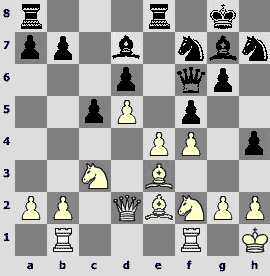
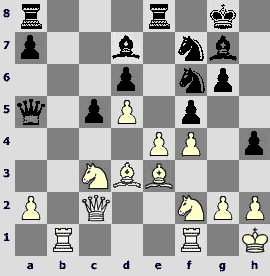
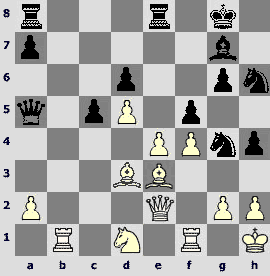
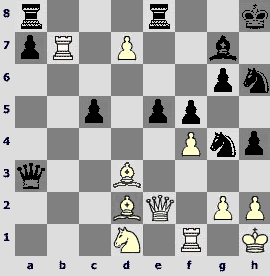
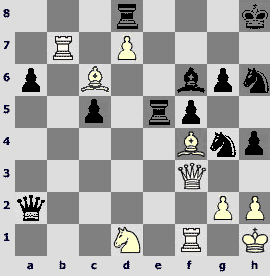
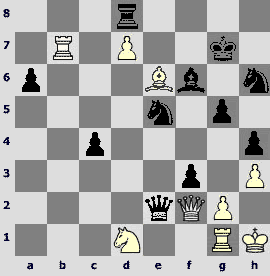
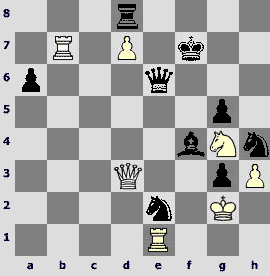
Continental Championship, Cali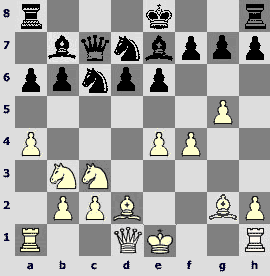
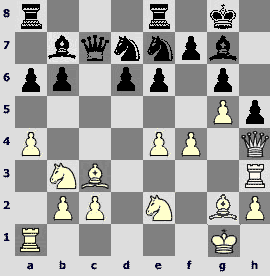
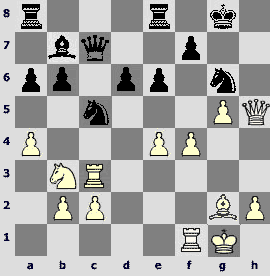

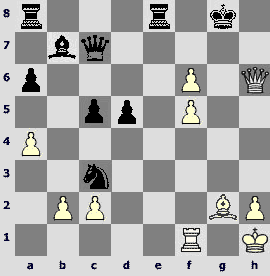
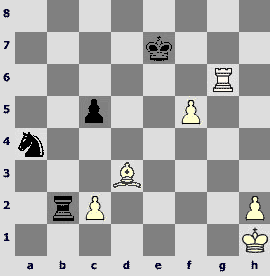
Biel open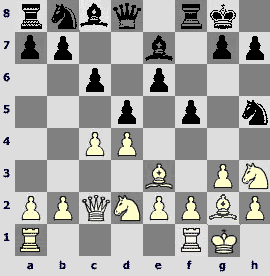

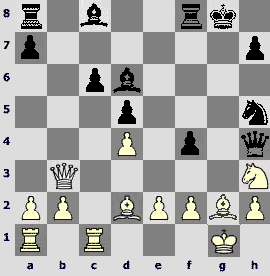
Pardubice
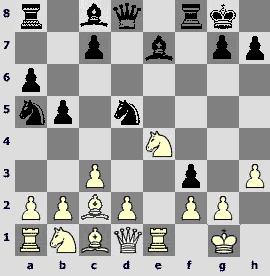
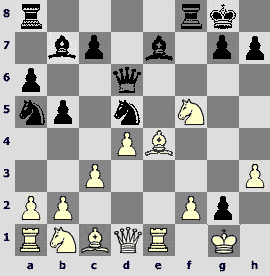
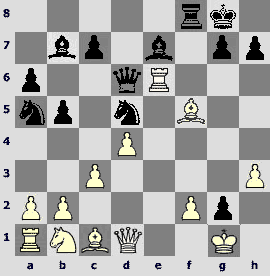
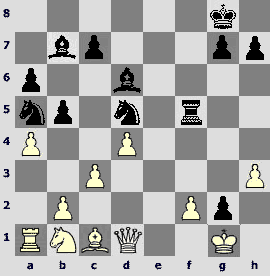
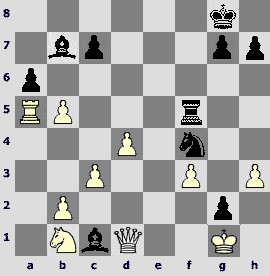
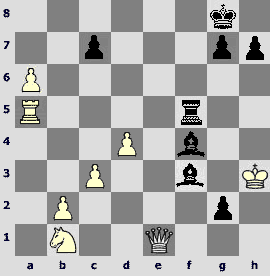
ALL ARTICLES BY AUTHOR

Discuss in forum